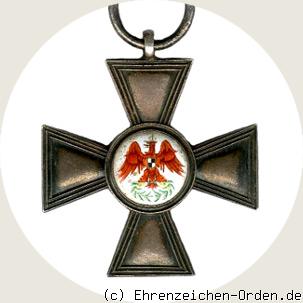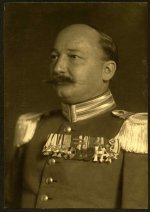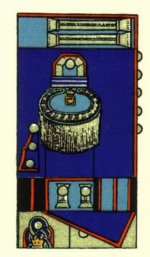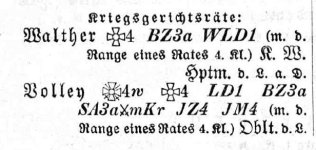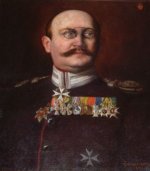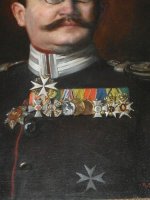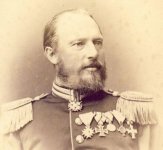Hi Joe,
don't get hung up about a lack of swords; we are talking about a guy serving at least twenty five years after the cessation of the Franco-Prussian War. There was not much scope for guys to be awarded combat awards in the Saxon Army at this time. We certainly know this guy is not any type of Saxon cavalry officer nor Field Artillery or Train (no pouch belts). We also know he does not belong to either GR 100 or GR 101 (no Litzen) or to SR 108 or the then three extant Saxon Jäger-Bataillonen. Remember the caption at the bottom of the Fricke card: "Generals and Regimental Commanders" - so he will not be Staff Officer, Landwehrbezirkskommandeur or anything obscure.
Another tip: there will always be the occasions when it is difficult, if not nearly impossible to ID a decoration from a blurry photograph. That being the case, go with the ones you can positvely ID and try to narrow down some suspects from those. Armed with a suspect who has the decorations you can identify, his entry in the Army List will give you a hint of the missing ones you can then look up for comparison. Don't worry about number 5 (Franco-Prussian War Commemorative Medal) as it will not be listed. Number three is still incorrect - you need something a little more prestigious than that.
What do we have so far (and this is the order they would be listed in the Saxon Army List after his name):
VR1 DAK ? EK2 (an Iron Cross symbol followed by a 2).
The DAK (Dienstauszeichnungskreuz) is the Officers' Long Service Decoration.
I had trouble accessing my online storage yesterday but here is the section of the index of Orders and Decorations in a Saxon Army List showing the Saxon abbreviations for the Order of Merit:
Regards
Glenn

don't get hung up about a lack of swords; we are talking about a guy serving at least twenty five years after the cessation of the Franco-Prussian War. There was not much scope for guys to be awarded combat awards in the Saxon Army at this time. We certainly know this guy is not any type of Saxon cavalry officer nor Field Artillery or Train (no pouch belts). We also know he does not belong to either GR 100 or GR 101 (no Litzen) or to SR 108 or the then three extant Saxon Jäger-Bataillonen. Remember the caption at the bottom of the Fricke card: "Generals and Regimental Commanders" - so he will not be Staff Officer, Landwehrbezirkskommandeur or anything obscure.
Another tip: there will always be the occasions when it is difficult, if not nearly impossible to ID a decoration from a blurry photograph. That being the case, go with the ones you can positvely ID and try to narrow down some suspects from those. Armed with a suspect who has the decorations you can identify, his entry in the Army List will give you a hint of the missing ones you can then look up for comparison. Don't worry about number 5 (Franco-Prussian War Commemorative Medal) as it will not be listed. Number three is still incorrect - you need something a little more prestigious than that.
What do we have so far (and this is the order they would be listed in the Saxon Army List after his name):
VR1 DAK ? EK2 (an Iron Cross symbol followed by a 2).
The DAK (Dienstauszeichnungskreuz) is the Officers' Long Service Decoration.
I had trouble accessing my online storage yesterday but here is the section of the index of Orders and Decorations in a Saxon Army List showing the Saxon abbreviations for the Order of Merit:
Regards
Glenn

Last edited:


